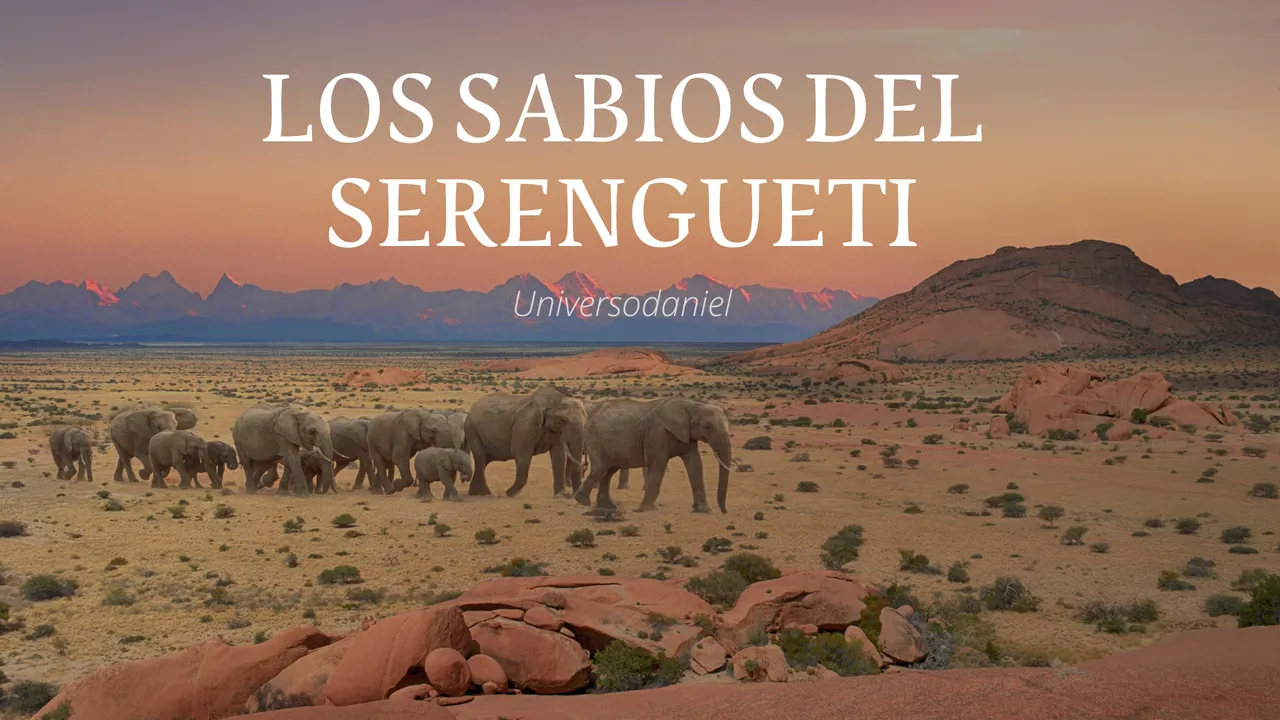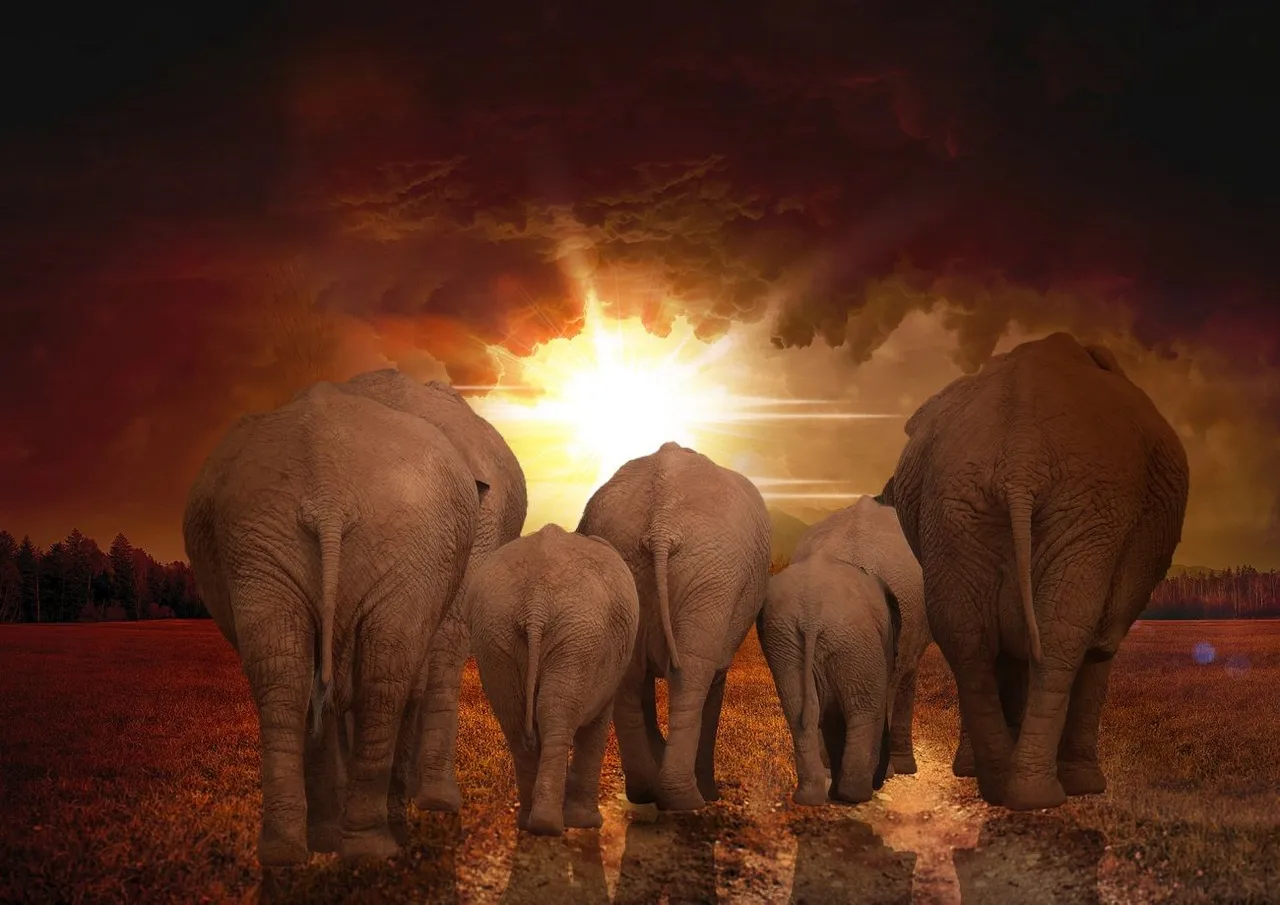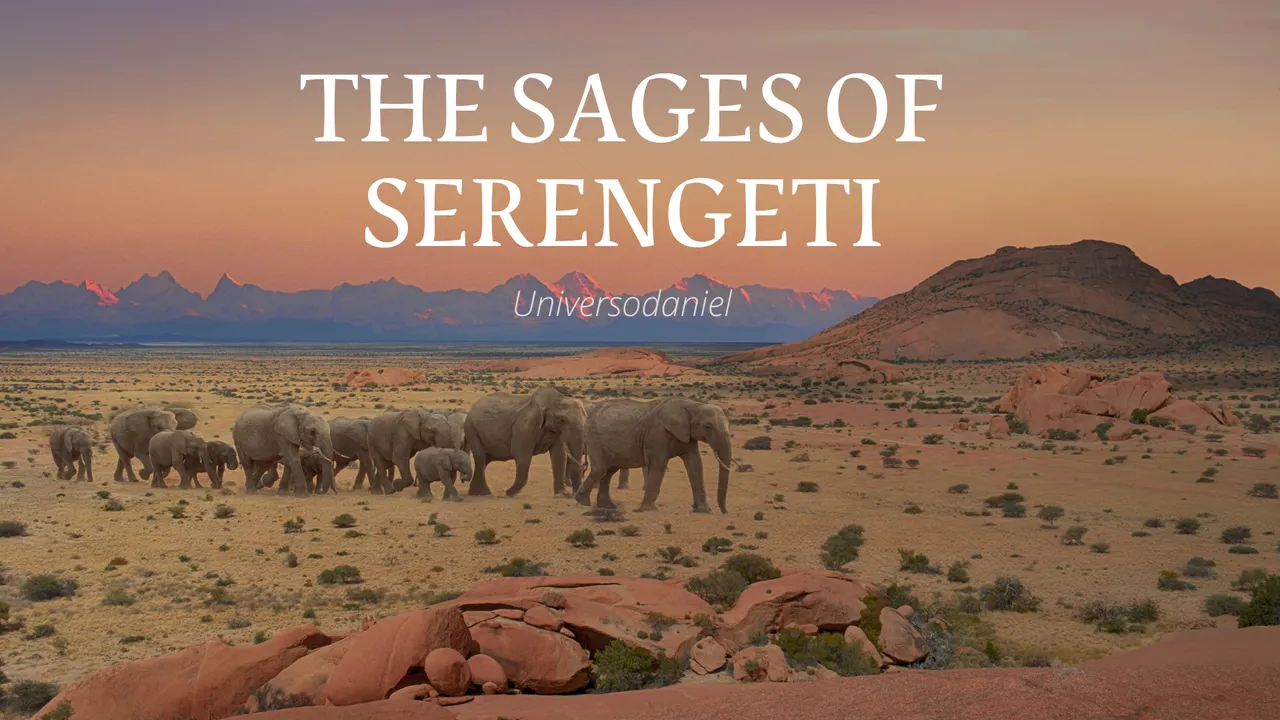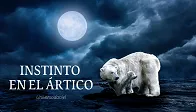 Pixabay by Elg21
Pixabay by Elg21Serengueti, hace un tiempo atrás.
La impresionante vida salvaje de la llanura del Serengueti reinaba en aquellos tiempos. Aves, reptiles y mamíferos convivían dentro de un ecosistema que se retroalimentaba de forma natural. Cada especie animal, dependía de sí mismo para sobrevivir, pero también era indispensable depender de las demás especies y de la misma naturaleza del antiguo ambiente del Serengueti.
Por alguna extraña circunstancia las lluvias que debieron haber caído en una determinada época del año, no lo hicieron. Y no lo hicieron durante años. La mayoría de los animales se vieron obligados a emigrar en busca de agua y comida. Muchos perecieron en el camino y otros perecieron sin haber emigrado. Las manadas de los elefantes, eran los que más se movían de un sitio para otro y al parecer eran los que resistían con ahínco la sequía.
Eran los primeros en descubrir antiguos lugares donde una vez surcaba el agua, pero lamentablemente llegaban tarde y ya la sequía se había apoderado del vital líquido. Solo quedaba de esos lugares la tierra húmeda y con suerte el fango que agarraban con su trompa y se regaban por todo el cuerpo para mantenerse frescos. Atrás venia el restos de los animales que de una u otra manera imitaban el comportamiento de estos grandes mamíferos. Fue así que muchos de los reptiles y aves por mencionar algunas especies, aguantaron la implacable sequía, siguiendo a los elefantes a donde quisiera que fuesen.
Pero lo peor estaba por llegar. Inmensas llamaradas de un fuego incandescente y abrumador, empezaron a consumir lo poco que quedaba de vegetación. Los árboles y multitud de animales ardían al ritmo del fuego. Lo que una vez fue inmensas colinas verdosas, quedó reducida a cenizas que se expandían por todo el lugar, iniciando nuevamente el fuego en aquellos sitios por donde la candela no había pasado.
Muchos animales salían velozmente de la llanura sin un rumbo fijo. El fuego se mantuvo vivo por varios meses. La gran mayoría de los animales del lugar perecieron y los pocos que aun permanecían con vida, estaban convalecientes, habían pasado semanas sin poder absorber una gota de agua.
Allá a lo lejos, lo elefantes habían formado un circulo alrededor de unos árboles de troncos muy delgados y hojas alargadas, que aún no habían sido consumido por el fuego, y embestían contra ellos derrumbándolos de raíz. Debajo de estos árboles la tierra estaba húmeda y en mucho de ellos aún había agua. Esta escena se convirtió en un ritual para los elefantes. Cada vez que encontraban esos tipos de árboles, golpeaban el suelo con sus enormes patas y empezaban a barritar y mover las orejas desesperadamente. Era de esta manera como se comunicaban con los demás elefantes indicándoles su descubrimiento.
Muchos otros animales, hicieron lo mismo que los elefantes. Los rinocerontes por ejemplo, fueron los primeros en imitar este comportamiento, luego le siguieron los hipopótamos, los impalas, el ñu, el búfalo e incluso con el tiempo las aves sobrevolaban los cielos y aprendieron a identificar estos árboles para luego comunicárselos a los demás animales. Estas especies de árboles fue mermando, bien sea, consumido por el fuego o derribado por los animales. Y aunque gracias a dichos árboles y a los elefantes, muchos de las demás especies de animales sobrevivieron, otros continuaban sucumbiendo ante el fuego y la sequía.
A donde quiera que se mirara hacia el horizonte, lo que se podía contemplar era una llanura convertida en cenizas por un lado. Hacia otro lado, columnas de fuego no dejaban de consumir lo poco que quedaba de vegetación. En los lugares del Serengueti, en el que se podía contemplar vida, siempre había una manada de elefantes rodeados por grupos de diferentes especies de animales a su alrededor, a la espera del siguiente movimiento para ir tras ellos. Los elefantes eran la única esperanza que se tenía para sobrevivir.
Un día, se ajuntaron en un solo sitio una enorme cantidad de elefantes, como la que nunca el Serengueti había visto y a partir de allí, empezó la mayor de las migraciones de animales. Inmensas caravanas de elefantes se dirigían hacia la cima de una montaña. Y tras ellos el restos de las demás especies que aún permanecían con vida.
 Pixabay by AndreyС
Pixabay by AndreyСLa travesía duraría semanas, muchos guepardos, leones, babuinos, aves y demás animales sucumbieron en el trayecto. En ocasiones la caravana se paraba en determinados lugares y las matriarcas se reunían alrededor y empezaban a acariciar el suelo como si de un ritual se tratase, en muchas de las veces lo hicieron cuando encontraban osamentas de elefantes que habían fallecidos tiempo atrás. El ritual duraba poco tiempo y posteriormente emprendían nuevamente el viaje.
Fueron muchas las semanas que duró la migración hasta que finalmente la caravana de elefantes junto al restos de los animales llegaron a la cima de la montaña. Esta no era muy empinada pero si inmensa en anchura. Era un valle verdoso con un lago en el centro y alrededor de ese valle lo rodeaban cerros en forma circular como si de guardianes montañosos se tratara. Al llegar, las matriarcas observaron que ya había diferentes animales habitando el lugar y junto a ellos enormes elefantes resaltaban entre las demás especies.
Las matriarcas se dirigieron hacia sus parientes y empezaron a agruparse y con sus largas trompas uno a uno se acarició entre ellos, como señal de que habían logrado su cometido o habían entendido la misión. Si se pudiera describir ese comportamiento, sería como una especie de felicitaciones en medio de una festividad entre ellos. Así, cada día durante semanas, nuevas filas de elefantes llegaban al valle y tras ellos el resto de los animales.
Fue en ese lugar en el que un nuevo ecosistema surgió y gracias a la sabiduría, resistencia y memoria de los elefantes un renacer del Serengueti emergió y junto a ellos, los demás animales que hoy en día conviven en la región. Es por eso, que cada especie animal, incluyendo las aves y los reptiles le guardan respeto a estos gigantescos paquidermos que en un pasado salvaron a gran parte de la fauna del Serengueti. Hoy en día a ese lugar al cual llegaron los elefantes, se le conoce como Ngorongoro y sabemos que forma parte de una gran caldera volcánica, que fue bautizada con el mismo nombre.
 Pixabay by Jcoope12
Pixabay by Jcoope12GLOSARIO
SERENGUETI: El Serengueti es el Parque Nacional con la mayor colección de fauna de Tanzania. La palabra “Serengueti” proviene del masai “siringet” que hace referencia a un “lugar que se extiende hasta el infinito” o “llanura infinita”. Fuente
CRÁTER DE NGORONGORO: está ubicado en el borde oriental del Serengeti al norte de Tanzania. Se cree que hace unos tres millones de años pudo ser una de las montañas más altas del mundo, pero se colapsó y, antes de explotar, se derrumbó formando la caldera más antigua del mundo. Fuente
 Pixabay by Elg21
Pixabay by Elg21Serengeti, some time ago.
The impressive wildlife of the Serengeti plains reigned in those times. Birds, reptiles and mammals lived together in a naturally feeding ecosystem. Each animal species depended on itself to survive, but it was also indispensable to depend on the other species and on the very nature of the ancient Serengeti environment.
For some strange circumstance, the rains that should have fallen at a certain time of the year, did not. And they did not for years. Most of the animals were forced to migrate in search of food and water. Many perished on the way and others perished without having migrated. The herds of elephants were the ones that moved the most from one place to another and it seems that they were the ones that resisted the drought.
They were the first to discover ancient places where water once flowed, but unfortunately they were late and the drought had already taken hold of the vital liquid. All that remained of those places was the damp earth and, if they were lucky, the mud that they grabbed with their trunks and watered all over their bodies to keep cool. Behind them came the remains of the animals that in one way or another imitated the behavior of these great mammals. So it was that many of the reptiles and birds, to mention a few species, endured the relentless drought, following the elephants wherever they went.
But the worst was yet to come. Huge blazes of overwhelming, incandescent fire began to consume what little vegetation remained. Trees and a multitude of animals burned to the rhythm of the fire. What once was once immense greenish hills, was reduced to ashes that spread all over the place, starting the fire again in those places where the candle had not passed.
Many animals were leaving the plain without a fixed direction. The fire was kept alive for several months. The great majority of the animals of the place perished and the few that still remained alive, were convalescent, they had spent weeks without being able to absorb a drop of water.
In the distance, the elephants had formed a circle around some trees with very thin trunks and elongated leaves, which had not yet been consumed by the fire, and they charged at them, knocking them down by the roots. Underneath these trees the earth was damp and in many of them there was still water. This scene became a ritual for the elephants. Whenever they encountered these types of trees, they would hit the ground with their huge feet and begin to chitter and wiggle their ears desperately. This was how they communicated with the other elephants about their discovery.
Many other animals did the same as the elephants. Rhinoceroses, for example, were the first to imitate this behavior, then followed by hippopotamuses, impalas, wildebeest, buffalo and even, with time, birds flew over the skies and learned to identify these trees and then communicate them to the other animals. These species of trees were diminishing, either consumed by fire or felled by animals. And although thanks to these trees and the elephants, many of the other animal species survived, others continued to succumb to fire and drought.
Wherever one looked to the horizon, what could be seen was a plain turned to ashes on one side. On the other side, columns of fire consumed what little vegetation remained. In the places of the Serengeti, where life could be seen, there was always a herd of elephants surrounded by groups of different species of animals around them, waiting for the next move to go after them. Elephants were the only hope for survival.
One day, an enormous number of elephants, the likes of which the Serengeti had never seen before, gathered in one place and from then on, the greatest of all animal migrations began. Huge caravans of elephants were heading towards the top of a mountain. And behind them the remains of the other species that were still alive.
 Pixabay by AndreyС
Pixabay by AndreyСThe journey would last for weeks, many cheetahs, lions, baboons, birds and other animals succumbed along the way. Sometimes the caravan stopped in certain places and the matriarchs gathered around and began to caress the ground as if it were a ritual, many times they did it when they found bones of elephants that had died some time before. The ritual lasted a short time and then they would start their journey again.
The migration lasted many weeks until finally the caravan of elephants together with the remains of the animals reached the top of the mountain. It was not very steep but immense in width. It was a greenish valley with a lake in the center and around the valley were circular hills as if they were mountain guardians. Upon arrival, the matriarchs observed that there were already different animals inhabiting the place and next to them huge elephants stood out among the other species.
The matriarchs headed towards their relatives and began to group together and with their long trunks one by one they caressed each other, as a sign that they had achieved their task or had understood the mission. If one could describe that behavior, it would be as a kind of congratulations in the midst of a festivity among them. Thus, every day for weeks, new lines of elephants arrived in the valley and after them the rest of the animals.
It was in that place where a new ecosystem emerged and thanks to the wisdom, resistance and memory of the elephants a rebirth of the Serengeti emerged and along with them, the other animals that today coexist in the region. That is why every animal species, including birds and reptiles, have respect for these gigantic pachyderms that in the past saved a large part of the Serengeti's fauna. Today, the place where the elephants arrived is known as Ngorongoro and we know that it is part of a large volcanic caldera, which was baptized with the same name.
 Pixabay by Jcoope12
Pixabay by Jcoope12GLOSSARY
SERENGETI: The Serengeti is the National Park with the largest collection of wildlife in Tanzania. The word "Serengeti" comes from the Masai "siringet" which refers to a "place that extends to infinity" or "infinite plain". Source
NGORONGORO CRATER: it is located on the eastern edge of the Serengeti in northern Tanzania. It is believed that about three million years ago it could have been one of the highest mountains in the world, but it collapsed and, before exploding, it collapsed forming the oldest caldera in the world. Source
Este escrito es mi entrada al concurso hispaliterario 7 promovido por los compañeros de las comunidades @hispapro, @es-literatos @celf.magazine y @writingclub en conmemoración al Día Mundial del Elefante.
Me despido de ustedes, esperando que este escrito haya sido de su agrado y extendiendo el llamado a participar a los amigos @albanyescribe y @karelysk89 a que se unan a esta maravillosa aventura literaria. Por acá les estaré dejando el link de invitación.
This writing is my entry to the hispaliterario 7 contest promoted by fellow members of the @hispapro, @es-literatos @celf.magazine and @writingclub communities in commemoration of World Elephant Day.
I say goodbye to you, hoping that this writing has been to your liking and extending the call to participate to friends @albanyescribe and @karelysk89 to join this wonderful literary adventure. I will be leaving the invitation link here.
Thanks for reading, see you next time friends!
||||
I invite you to see more of my publications that might interest you.
| La Duquesa Alaine |  |
|---|---|
| Hispaliterario 6 / Instinto en el Ártico |  |
| Bajo la capa de Greldar (1era parte) |  |